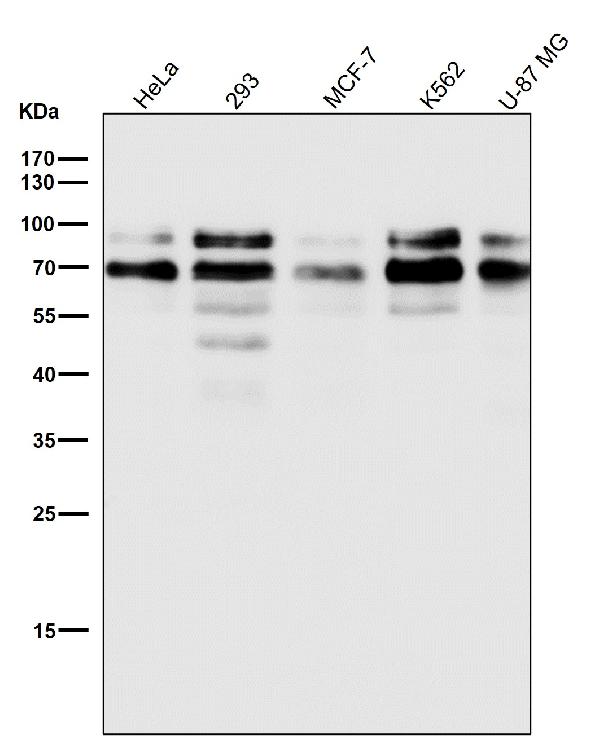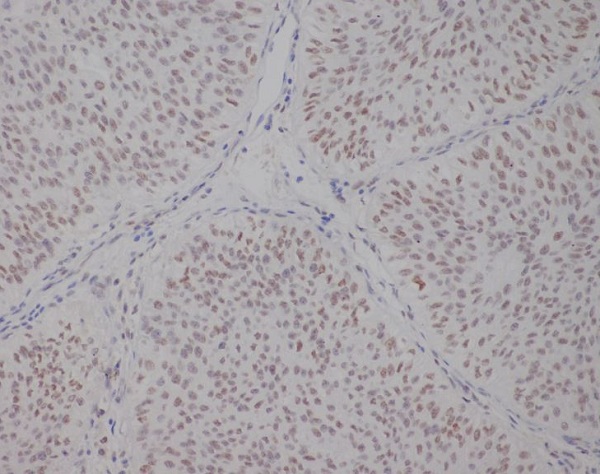Anti-TFE3 Monoclonal Antibody
- SPECIFICATION
- CITATIONS
- PROTOCOLS
- BACKGROUND

Application
| IHC, IF, ICC, FC |
|---|---|
| Primary Accession | P19532 |
| Host | Rabbit |
| Isotype | Rabbit IgG |
| Reactivity | Human |
| Clonality | Monoclonal |
| Format | Liquid |
| Description | Anti-TFE3 Monoclonal Antibody . Tested in IHC, ICC/IF, Flow Cytometry applications. This antibody reacts with Human. |
| Gene ID | 7030 |
|---|---|
| Other Names | Transcription factor E3, Class E basic helix-loop-helix protein 33, bHLHe33, TFE3 {ECO:0000303|PubMed:9393982, ECO:0000312|HGNC:HGNC:11752} |
| Calculated MW | 61521 Da |
| Application Details | IHC 1:50-1:200 ICC/IF 1:50-1:100 FC 1:50 |
| Contents | Rabbit IgG in phosphate buffered saline, pH 7.4, 150mM NaCl, 0.02% sodium azide and 50% glycerol, 0.4-0.5mg/ml BSA. |
| Clone Names | Clone: AFHC-20 |
| Immunogen | A synthesized peptide derived from human TFE3 |
| Purification | Affinity-chromatography |
| Storage | Store at -20°C for one year. For short term storage and frequent use, store at 4°C for up to one month. Avoid repeated freeze-thaw cycles. |
| Name | TFE3 {ECO:0000303|PubMed:9393982, ECO:0000312|HGNC:HGNC:11752} |
|---|---|
| Function | Transcription factor that acts as a master regulator of lysosomal biogenesis and immune response (PubMed:2338243, PubMed:24448649, PubMed:29146937, PubMed:30733432, PubMed:31672913, PubMed:37079666). Specifically recognizes and binds E-box sequences (5'-CANNTG-3'); efficient DNA-binding requires dimerization with itself or with another MiT/TFE family member such as TFEB or MITF (PubMed:24448649). Involved in the cellular response to amino acid availability by acting downstream of MTOR: in the presence of nutrients, TFE3 phosphorylation by MTOR promotes its inactivation (PubMed:24448649, PubMed:31672913, PubMed:36608670). Upon starvation or lysosomal stress, inhibition of MTOR induces TFE3 dephosphorylation, resulting in transcription factor activity (PubMed:24448649, PubMed:31672913, PubMed:36608670). Specifically recognizes and binds the CLEAR-box sequence (5'-GTCACGTGAC-3') present in the regulatory region of many lysosomal genes, leading to activate their expression, thereby playing a central role in expression of lysosomal genes (PubMed:24448649). Maintains the pluripotent state of embryonic stem cells by promoting the expression of genes such as ESRRB; mTOR- dependent TFE3 cytosolic retention and inactivation promotes exit from pluripotency (By similarity). Required to maintain the naive pluripotent state of hematopoietic stem cell; mTOR-dependent cytoplasmic retention of TFE3 promotes the exit of hematopoietic stem cell from pluripotency (PubMed:30733432). TFE3 activity is also involved in the inhibition of neuronal progenitor differentiation (By similarity). Acts as a positive regulator of browning of adipose tissue by promoting expression of target genes; mTOR-dependent phosphorylation promotes cytoplasmic retention of TFE3 and inhibits browning of adipose tissue (By similarity). In association with TFEB, activates the expression of CD40L in T-cells, thereby playing a role in T-cell- dependent antibody responses in activated CD4(+) T-cells and thymus- dependent humoral immunity (By similarity). Specifically recognizes the MUE3 box, a subset of E-boxes, present in the immunoglobulin enhancer (PubMed:2338243). It also binds very well to a USF/MLTF site (PubMed:2338243). Promotes TGF-beta-induced transcription of COL1A2; via its interaction with TSC22D1 at E-boxes in the gene proximal promoter (By similarity). May regulate lysosomal positioning in response to nutrient deprivation by promoting the expression of PIP4P1 (PubMed:29146937). |
| Cellular Location | Cytoplasm, cytosol. Nucleus. Lysosome membrane. Note=When nutrients are present, recruited to the lysosomal membrane via association with GDP-bound RagC/RRAGC (or RagD/RRAGD): it is then phosphorylated by MTOR (PubMed:24448649, PubMed:37079666). Phosphorylation by MTOR prevents nuclear translocation and promotes ubiquitination and degradation (PubMed:22692423, PubMed:30733432, PubMed:36608670, PubMed:37079666) Conversely, inhibition of mTORC1, starvation and lysosomal disruption, promotes dephosphorylation and translocation to the nucleus (PubMed:22692423, PubMed:30733432, PubMed:37079666) |
| Tissue Location | Ubiquitous in fetal and adult tissues. |

Thousands of laboratories across the world have published research that depended on the performance of antibodies from Abcepta to advance their research. Check out links to articles that cite our products in major peer-reviewed journals, organized by research category.
info@abcepta.com, and receive a free "I Love Antibodies" mug.
Provided below are standard protocols that you may find useful for product applications.
If you have used an Abcepta product and would like to share how it has performed, please click on the "Submit Review" button and provide the requested information. Our staff will examine and post your review and contact you if needed.
If you have any additional inquiries please email technical services at tech@abcepta.com.













 Foundational characteristics of cancer include proliferation, angiogenesis, migration, evasion of apoptosis, and cellular immortality. Find key markers for these cellular processes and antibodies to detect them.
Foundational characteristics of cancer include proliferation, angiogenesis, migration, evasion of apoptosis, and cellular immortality. Find key markers for these cellular processes and antibodies to detect them. The SUMOplot™ Analysis Program predicts and scores sumoylation sites in your protein. SUMOylation is a post-translational modification involved in various cellular processes, such as nuclear-cytosolic transport, transcriptional regulation, apoptosis, protein stability, response to stress, and progression through the cell cycle.
The SUMOplot™ Analysis Program predicts and scores sumoylation sites in your protein. SUMOylation is a post-translational modification involved in various cellular processes, such as nuclear-cytosolic transport, transcriptional regulation, apoptosis, protein stability, response to stress, and progression through the cell cycle. The Autophagy Receptor Motif Plotter predicts and scores autophagy receptor binding sites in your protein. Identifying proteins connected to this pathway is critical to understanding the role of autophagy in physiological as well as pathological processes such as development, differentiation, neurodegenerative diseases, stress, infection, and cancer.
The Autophagy Receptor Motif Plotter predicts and scores autophagy receptor binding sites in your protein. Identifying proteins connected to this pathway is critical to understanding the role of autophagy in physiological as well as pathological processes such as development, differentiation, neurodegenerative diseases, stress, infection, and cancer.



